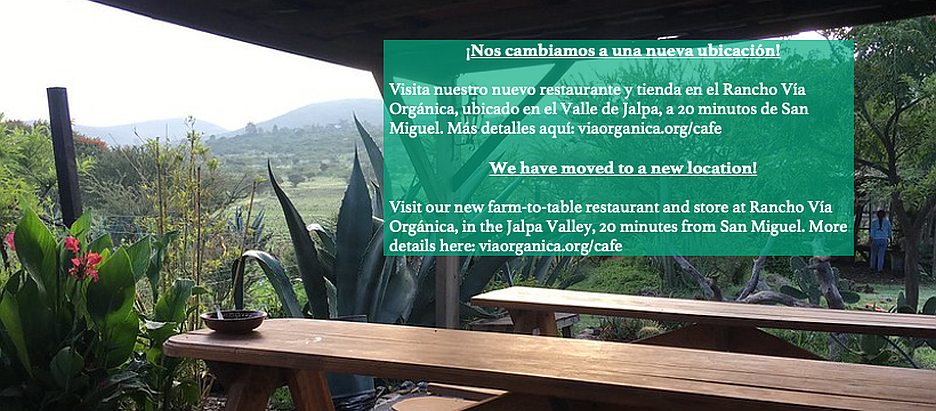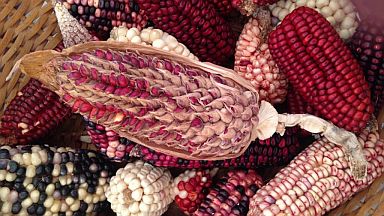Corn Festival—Festival del Maíz [] Rancho Vía Orgánica
Event Category: Food & Drink and Learning/Education
-
Sun, Sep 26, 10am-6pm
Rancho Vía Orgánica
WhatsApp reservation: 415 117 2236
September is the national month, where we celebrate being Mexicans in various ways. One of them is through food, which is based on corn. Many dishes of pre-Hispanic origin that are still consumed to date come from“el maíz”. That is why in Mexico corn is king and has a day to celebrate it: September 29.
However, in Vía Orgánica, a non-profit organization from San Miguel, whose mission is to promote organic agriculture, fair trade and a healthy lifestyle, native corn will be celebrated with a festival on Sunday, September 26.
Visitors will be able to see and interact with the crops. In the celebration, besides the exhibition and talks by Julio César, there will be a tasting of dishes made with products from the milpa in a very Mexican kermesse.
The Corn Festival is a celebration of the entire milpa system, whereby corn, beans, and squash coexist in the same plot. Azucena Cabrera who is responsible for crops at Via Orgánica, told us that in the corn house, edible plants such as quelites (pigweed) or purslane coexist, as well as pollinating plants such as sunflower, cosmos, and toritos (little bulls). The latter is so called because when the plant dries, the seeds remain in a capsule with two ends resembling the horns of a bull. It is easy for them to get attached to animals and thus spread through the fields; it is how they survive. Medicinal plants, such as mullein (used for tea to relieve stomach pain) or Juan Mecate, a plant whose paste can heal bone fractures, also grow in the corn house. “We healed a donkey’s leg with Juan Mecate,” said Cabrera, and added that “the milpa is an example of how to work with regenerative agriculture, because with diversity the soil will be healthy, it generates its own matter. This event is a window onto vernacular and native agriculture to be learned and valued.” The program manager also explained another reason why corn landscapes are diverse. “When we see the landscape, we see in the cornfields that the stalks’ heights are uneven. They are irregular because they are native species of the area adapted to local conditions. They manifest themselves in different ways.”
Native corn can grow at altitudes ranging from 0 to 3,200 meters above sea level. For this reason, it is clear why we see it in the stony terrain of the mountains of Jalpa, in the soft fields of Don Diego, and even in parts of the Guanajuato mountain range.
The corn stalks we see growing around San Miguel de Allende are not consistent in spacing in the fields nor in size. Why became clear when we talked to farmers in Pedregudo. They told us that some furrows are empty because squirrels dig up and eat the seeds. In the Don Diego plots, the inconsistency is because once the stalk has grown, fall armyworm or grasshopper plagues can kill them. “There is no money for fertilizer,” they say. What is consistent is that native corn will grow in spite of little precipitation, and will provide sustenance for the producers themselves or commercially.
“Corn was a grass; we cannot defend what we do not know”
Julio César is 28 years old, lives in Oaxaca, and has a degree in Planning for Rural Development. He has been a volunteer for Greenpeace and has been campaigning for ten years to protect native corn. “I am passionate about corn, and in recent years I have set out to try to make known its biocultural richness, the dishes made from it, and the worldview of the peoples that cultivate it, its history and evolution,” he commented to Atencion.
As he travelled the states of the Republic, Julio César realized that the ears of corn in Oaxaca were very different from those in Puebla, and their characteristics differed from those of Guanajuato or Tlaxcala. This prompted him to begin collecting the different types of corn, so when there is an opportunity he can exhibit them and people will learn about the nutritional wealth of the country and protect the grain. “We cannot defend what we do not know,” he asserted. He says that there are still Mexicans who ask him “What do you paint the cobs with?” He continued, “There is a great gap between those who consume and those who produce. That’s where my passion for this food was born.”
Julio, who is an expert on the subject, said that ajo corn is characterized by the fact that each grain is protected by a wrapper like garlic cloves are. “It is the missing link to the ancestor of teosinte corn, which during domestication was left with the wrappers.” According to Julio, it is believed that the domestication of corn occurred about seven thousand years ago: “It was a wild grass, and the only thing people consumed was its sweet juice, but as agriculture developed, the seeds of the existing varieties were transferred throughout different parts of the continent and developed.” He added that in ancient corn, the kernel was exposed and the ear was not covered by husks.
He says that governments generate hybrids to improve production, however what should be done is to plant only native corn adapted to each location and climate.
Julio is known as “El Niño Maíz” (the corn boy). He has been invited to the celebration of the third Corn Festival at Rancho Vía Orgánica on Sunday, September 26, and will give two talks that day, at 11:30am and at 1:30pm. He will bring his collection of ears of corn from Veracruz, Puebla, Oaxaca, Tlaxcala, Mexico City, Guanajuato, and other areas.
Attendance at the event will be limited. To reserve or to get more information, contact Rancho Vía Orgánica via WhatsApp on 415 117 2236.

Organic Via Café at the Ranch
Delicious, Local, Organic Attention: We have closed our location on Calle Margarito Ledesma # 2, Colonia Guadalupe, San Miguel de Allende, Guanajuato. We moved to a new location!
About the new location
Try our new restaurant menu “from farm to table” and buy fresh farm products at Rancho Vía Orgánica, located in the Jalpa Valley, 20 minutes from San Miguel. Open every day. OPEN ON GOOGLE MAPS At the restaurant ranch, we are here to serve you from 8:00 a.m. to 6:00 p.m., Monday through Sunday.
You can make reservations here:
Office: 442 757 0430
Store: 442 757 0490
Website: www.viaorganica.org
Your purchase supports the healthy, fair and supportive organic movement.
-
-

